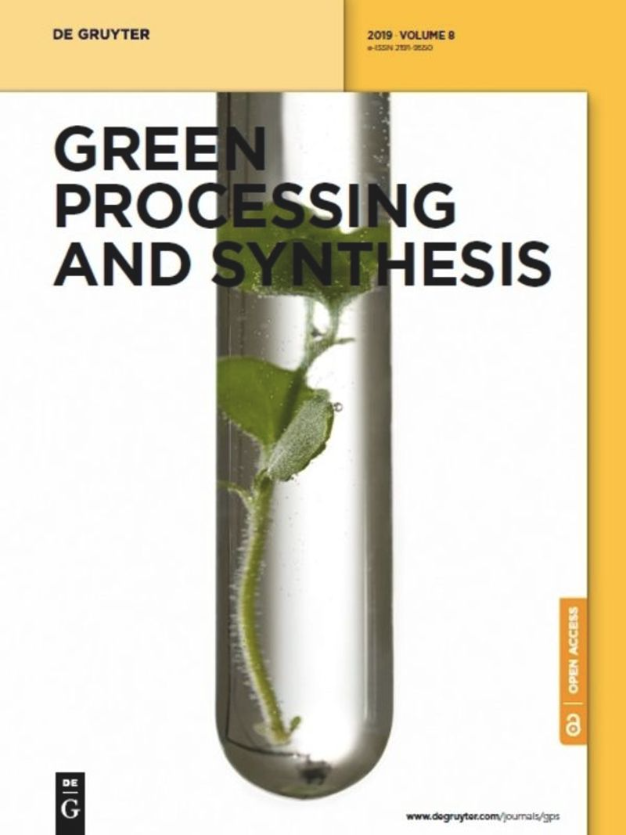Green synthesis of silver nanoparticles using durian rind extract and optical characteristics of surface plasmon resonance-based optical sensor for the detection of hydrogen peroxide
IF 3
4区 工程技术
Q2 CHEMISTRY, MULTIDISCIPLINARY
引用次数: 0
Abstract
Abstract Silver nanoparticles (AgNPs) have been efficaciously synthesized from AgNO 3 via an easy and green method, also called green synthesis, using Mon Thong durian ( Durio zibethinus L.) rind extract. The inner shell of durian rind extract was used as an intermediary for the synthesis of AgNPs because the absorption spectra of the AgNP colloid extracted from the inner shell had a higher absorption than that of the outer shell. Additionally, we have found more fructose and glucose – which act as a reducing agent – and protein and carbohydrates – which act as the stabilizer – in a higher amount in the inner shell than the extract from the outer shell. The synthesized AgNPs were mainly spherical in shape and exhibited a relatively narrow size distribution with an average particle diameter of 10.2 ± 0.2 nm. In the reduction of hydrogen peroxide (H 2 O 2 ), these nanoparticles demonstrate catalytic activity. The degradation of AgNPs, including the catalytic decomposition of H 2 O 2 , causes a considerable change in the absorbance strength of the surface plasmon resonance band depending on the H 2 O 2 concentration. Over a broad concentration range of 10 −1 –10 −6 mol·L −1 H 2 O 2 , a good sensitivity and a linear response are achieved. This sensor’s quantification limit is found to be 0.9 µmol·L −1 H 2 O 2 . Therefore, this optical sensor for the detection of H 2 O 2 can be potentially applied in the determination of color indicators in medical or clinical diagnosis, biochemical analysis, and environmental applications.利用榴莲皮提取物和光学特性合成绿色纳米银的表面等离激元共振光学传感器用于过氧化氢的检测
摘要以孟通榴莲(Durio zibethinus L.)果皮提取物为原料,以agno3为原料,采用简单、绿色的方法高效合成了纳米银。利用榴莲果皮提取物的内壳作为合成AgNP的中介,因为从内壳提取的AgNP胶体的吸收光谱比外壳的吸收光谱高。此外,我们还发现了更多的果糖和葡萄糖——作为还原剂——以及蛋白质和碳水化合物——作为稳定剂——在内壳中的含量高于从外壳中提取的含量。合成的AgNPs主要呈球形,粒径分布较窄,平均粒径为10.2±0.2 nm。在过氧化氢(h2o2)的还原中,这些纳米颗粒表现出催化活性。AgNPs的降解,包括h2o2的催化分解,导致表面等离子体共振带的吸光度强度随h2o2浓度的显著变化。在10−1 ~ 10−6 mol·L−1 h2o2的宽浓度范围内,具有良好的灵敏度和线性响应。该传感器的定量限为0.9µmol·L−1 h2o。因此,这种用于检测h2o2的光学传感器可以潜在地应用于医学或临床诊断、生化分析和环境应用中颜色指标的测定。
本文章由计算机程序翻译,如有差异,请以英文原文为准。
求助全文
约1分钟内获得全文
求助全文
来源期刊

Green Processing and Synthesis
CHEMISTRY, MULTIDISCIPLINARY-ENGINEERING, CHEMICAL
CiteScore
6.70
自引率
9.30%
发文量
78
审稿时长
7 weeks
期刊介绍:
Green Processing and Synthesis is a bimonthly, peer-reviewed journal that provides up-to-date research both on fundamental as well as applied aspects of innovative green process development and chemical synthesis, giving an appropriate share to industrial views. The contributions are cutting edge, high-impact, authoritative, and provide both pros and cons of potential technologies. Green Processing and Synthesis provides a platform for scientists and engineers, especially chemists and chemical engineers, but is also open for interdisciplinary research from other areas such as physics, materials science, or catalysis.
 求助内容:
求助内容: 应助结果提醒方式:
应助结果提醒方式:


